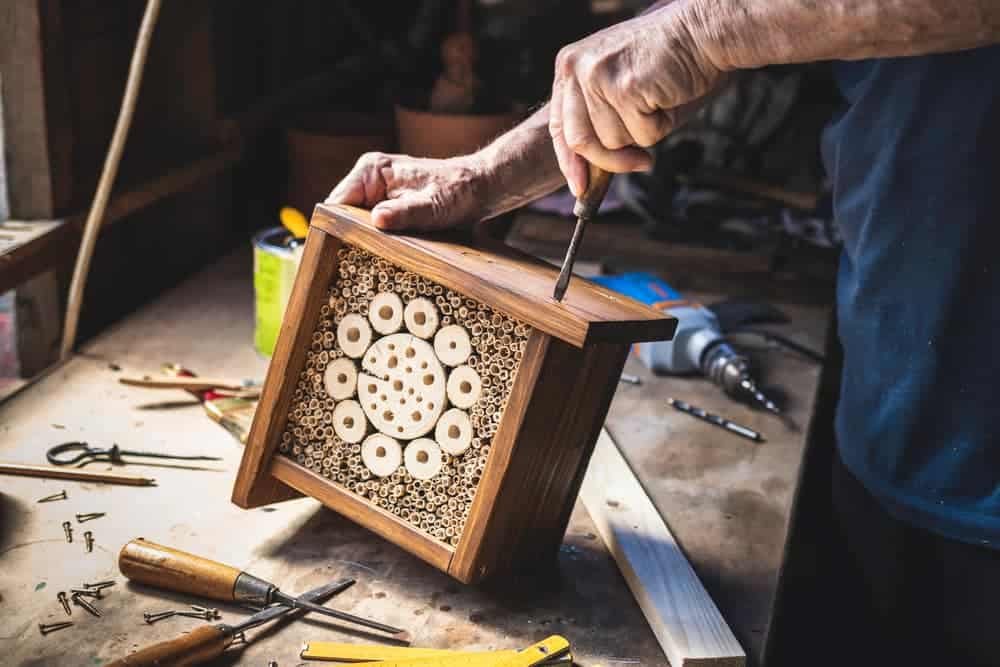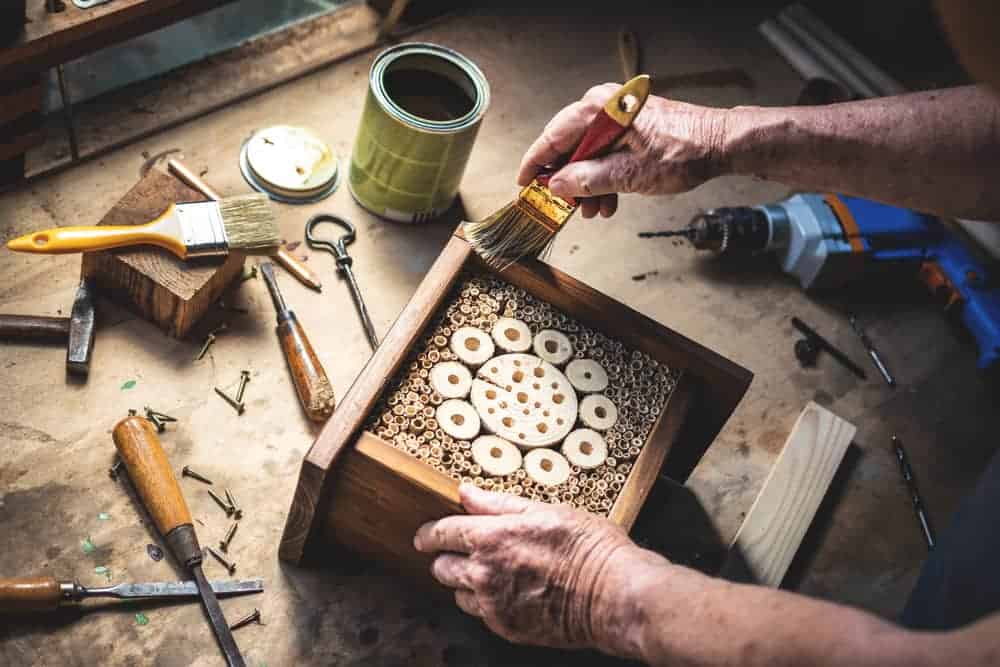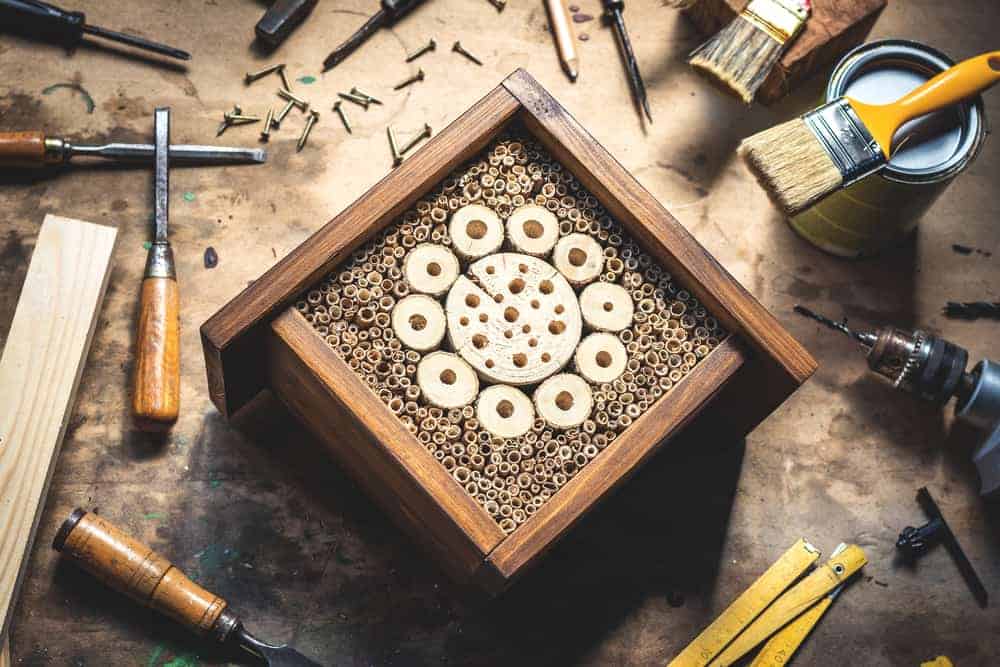Not all garden insects are harmful. Some help with pollination, organic matter decomposition or pest elimination. Encouraging these beneficial insects in our garden can also lessen the need for toxic chemical pesticides. So, if we want them to work for us, we need to offer them something to make them stay. How about a fancy DIY insect hotel? With this in your garden, you’ll be attracting a swarm of little helpers in no time!
What is an Insect Hotel?
An insect or bug hotel is a makeshift home for ladybirds, spiders, bees and other good garden insects. It’s the perfect place for them to thrive, lay eggs, grow their young and avoid predators. They won’t be paying fees for checking in your bespoke hotel, of course. But the good news is, these friendly invertebrates are not after five-star accommodation.
You can build your DIY insect hotel using recycled materials like pallets, old planks, drink bottles or pipes. Your winged and multi-legged guests would prefer a weatherproof hotel, though. And they would want a comfy bed made out of grass, straw, twigs, leaves, pine cones or any material that imitate their natural nesting habitat.
Why Should I Build a Bug Hotel?
Finding a suitable place for nesting and winter hibernation can be difficult for insects as people convert land and forests into buildings and homes. Native plants for food are also declining. Building insect houses for the garden will then invite them back and help them reproduce. When this happens, we garden owners get a lot of benefits in return:
- Boost ecological balance. The absence of an insect species can affect biodiversity and allow harmful pests to increase. Giving good insects a home ensures that the natural life cycle continues.
- Protect pollinators. An insect hotel can help butterflies, beetles, and moths thrive even in an urbanised area. It will also attract solitary bees who cannot travel far for food.
- Control garden pests. Beneficial insects feed on harmful ones to keep your garden thriving. Lacewing larvae, for instance, eat mealybugs, mites and caterpillars. Ladybugs can also help control aphids.
- Attract natural composters. Beetles settling in your DIY insect hotel is good news. That means you’ll have help in changing decaying plants or fruit into soil nutrients. With fertile soil, it will be effortless to grow healthy crops.
- Create a functional garden décor. Insect hotels are rustic works of art that can add interest to your garden setup. Also, you can use different stuffing materials to make them attractive to passers-by and various insects.

How Do I Build a DIY Insect Hotel?
The best thing about making homemade bug hotels is there’s no fixed rule. You can make it as big or as intricate as you want with any building material that you have. But to help you get started, here’s a list of basics.
Tools and Materials
| TOOLS | MATERIALS |
| Drill | Scrap timber or planks |
| Hammer and nails | Nesting materials: bamboo, leaves, dried leaves or flowers, straw, wool or bark |
| Glue gun or mud | Plastic bottles |
Steps
- Collect natural materials. If you have kids at home, ask them to do this for you!
- Build your wood box. While the kids are busy, join your scrap timber to create a house-shaped box. You can add dividers inside to make individual compartments (or hotel rooms).
- Pack your nesting material into each frame. Use a hot glue gun or mud to stick your gathered materials into each compartment. Ideally, use different materials to attract various insects to your DIY bug hotel. Here are some ideas:
-
- Insert bundled twigs or stems for ground beetles, ladybugs and hoverflies. These can help with pollination and pest control for aphids and mites.
- Stack dead wood or decaying logs for beetles, centipedes, and garden spiders. These can also attract woodlice and millipedes, which serve as food for birds.
- Add dried grass, straw or cardboard rolls for lacewings. Lacewings feed on aphids, caterpillars and mites. If you’re using cardboard or newspaper, stack them in open-ended plastic bottles to protect them from moisture.
- Drill holes in tree stumps for solitary bees and wasps. Make sure to create holes of different sizes to attract various species. Alternatively, you can use bundled hollow stems like bamboo canes.
- Let the glue or mud dry for a few days. After which, hang it and open your DIY insect hotel for business! You can also let it sit on the ground to attract crawling insects.

How Do I Get the Right Bugs into My DIY Insect Hotel?
Follow these additional building tips to ensure your bug hotel’s success!
- Keep your insect house small. It will prevent parasites from moving in and eating the larvae of beneficial garden bugs.
- Do not use treated timber. Chemicals in wood can repel insects. Avoid spraying garden pesticides near your DIY bug hotel, too.
- Avoid filling it with food scraps, nuts or acorns. These can only attract the wrong kind of guests, namely flies and their offspring.
- Cover the front with chicken wire to minimise bird activity. It will prevent woodpeckers and other birds from feeding on your hotel’s nesting materials.
- Place your hotel in a sheltered spot. The roof will protect your wooden box from deterioration due to weather elements like wind and rain. You can also paint it with a protective finish.
- Hang it away from doors or windows. Insects are excellent in the garden but not inside the house. Ideally, position your DIY bug hotel near your vegetable garden to make the most of the pollinators it will attract.
- Look for a sunny area for your bee hotel. While most insects prefer slightly damp homes, solitary bees prefer warm and dry locations.
- Find an insect hotspot. Bugs are likely to find their way into your hotel if it’s near a hedge, nectar-rich flower shrubs or a pond.
- Check your DIY insect hotel after a week or two. Relocate it if it is not attracting insects. Then clean it up and replace the bedding in late spring after insect eggs have hatched.


